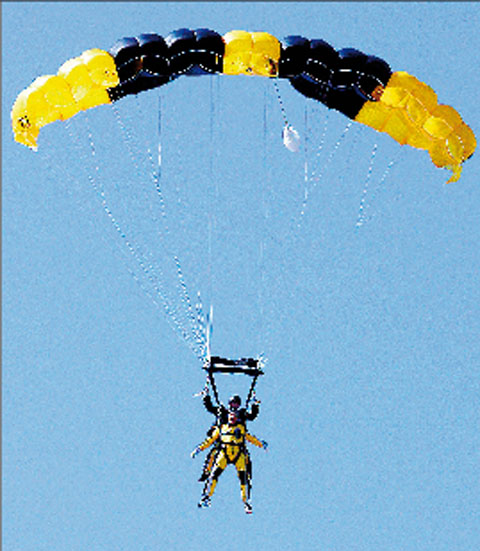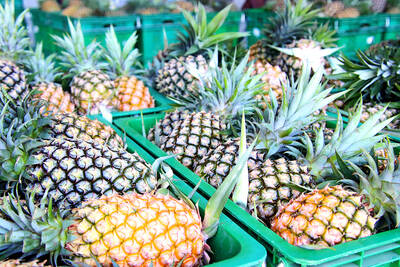Although parachutes have existed since the 10th century, parachutes as we know them were invented in the late 18th century. They were used as a means of escaping from damaged hot air balloons and were usually made of linen stretched over a wooden frame.
Since those early days, parachute design has come a long way. Modern parachutes are deployed in commercial and military aviation, and come in an array of shapes and sizes.
In today’s experiment we will build a simple parachute and learn about the forces that keep parachutes in the air.

PHOTO: AP
WHAT YOU WILL NEED:a plastic bag, string, adhesive tape, scissors, a hole punch, a toy figure and a stopwatch.
(JOHN PHILLIPS, STAFF WRITER)
雖然降落傘從西元十世紀就存在了,但我們現在所熟知的降落傘型式是到了十八世紀晚期才發明的。當時,降落傘是作為熱氣球毀損時的逃生器具,一般多以亞麻布攤覆在木頭支架上製成。
降落傘自早期發展至今,在設計上歷經許多改良。現代的降落傘主要作為商業和軍事飛航用途,並發展出一系列形狀、尺寸各異的傘具。
今天的實驗中,我們將自製一具簡單的降落傘,並了解降落傘在空中飄浮的原理。
實驗所需:一個塑膠袋、細繩、膠帶、剪刀、一個打洞機、一個玩具公仔、一個計時器。
(翻譯:袁星塵)
METHODOLOGY 實驗方法
Step 1: Cut a 15cm diameter circle from the plastic bag. Punch six holes at equal distances around the edge.
Step 2: Cut the string into six pieces. The length of the string should be 1.5 times the length of the circle’s diameter (15*1.5 = 22.5cm).
Step 3: Thread the string through the holes and tape them to your plastic circle. Tie or stick the loose ends to the toy figure.
Step 4: Go to a high point and drop the parachute. Time how long it takes for the parachute to fall to the ground.
步驟一:在塑膠袋上剪下一個直徑十五公分的圓形。在圓形週邊打六個等距離的洞。
步驟二:把細繩剪成六段,每一段的長度必須是圓形直徑的一點五倍長(也就是二十二點五公分)。
步驟三:把細繩分別穿入洞中,然後用膠帶把它們黏在塑膠圓形上。把另一端綁或黏在玩具公仔上。
步驟四:到高處去投放這個降落傘,記錄它落至地面所花的時間。
HOW IT WORKS 實驗原理
The toy doesn’t drop immediately to the ground because the parachute creates drag. Gravity is still pulling the toy down, but the air in the canopy acts against free fall. If gravity and air resistance were in equilibrium, the parachute would just hang motionless in the air. On the other hand, if the canopy were filled with hot air, the parachute would rise.
玩具不會立刻掉到地面上,是因為降落傘會產生阻力。重力仍然會把玩具向下拉,但降落傘包裡的空氣會阻抗自由落體運動。假設重力和空氣阻力大小相等,降落傘會靜止在空中。換句話說,如果傘包內充滿熱空氣,降落傘就會上升。
CHANGE THE VARIABLES 改變操縱變因
By changing one variable at a time, we are now going to find out what factors affect the rate of descent.
Here are some variables you can experiment with:
Change the weight of the payload (the toy).
Adjust the length of the strings.
Adjust the number of strings.
Increase and decrease the size of the canopy.
Cut some holes in the canopy.
Remember to measure each variable three times, then record the average time. Drop the parachute from the same height each time. If you know the height of the drop, you can calculate the speed using the following calculation:
Speed = height / time
Record the results in your science journal.
藉著每次改變一個操縱變因,我們要來找出影響降落傘下降速度的因素。
下列是你可以用來實驗的操縱變因:
改變載重量(玩具);
調整細繩的長度;
調整細繩的數量;
加大或縮小傘包尺寸;
在傘包上打幾個洞。
記住,每次改變操縱變因都要測量三次結果,再記錄下平均時間值;每次都要從同一個高度投放降落傘。如果知道投放降落傘處的高度,就可以利用下面這個公式算出降落傘落下的速度:
速度=高度�時間
在你的《科學日誌》中記錄實驗結果。

A: What types of fruit enzymes should we take to help reduce eye floaters? B: According to a study published in the “Applied Sciences” journal by Taiwanese ophthalmologist Horng Chi-ting, pineapple, papaya and fig supplements can improve symptoms. A: Pineapples are in season now, so you should munch on more of those to get rid of floaters. B: Not quite. Enzymes can be damaged by our stomach acid if we eat the fruit directly. The doctor says taking fruit enzyme capsules is better for absorption. A: Most importantly, we should reduce our use of personal electronics to prevent floaters from

Rice is essential to Japanese culture, tradition and politics. People take pride in the oval-shaped sticky Japonica grain, which is still a staple even though total consumption has fallen over the decades. But since last summer, prices have soared as supplies have fallen short of demand. The government has long paid farmers to cut back on rice acreage, and change to other crops to keep rice prices relatively high. To cope with shortfalls this year, the government has released rice reserves. But the grain has been slow to reach supermarket shelves. Anger over that was part of the reason the Agriculture Minister

In Taiwan, 7-Eleven convenience stores can be found on almost every street corner. With over 84,600 stores across 20 countries, 7-Eleven has more locations than any other retail business on Earth. For millions of people, the chain is an important part of daily life, providing coffee, quick meals, and essential items for those __1__. The history of 7-Eleven began nearly 100 years ago in Dallas, Texas. In 1927, the Southland Ice Company began selling blocks of ice that were used to keep fridges cool. Shortly after opening, the company __2__ its offerings to include groceries like milk, eggs, and

Continued from yesterday(延續自昨日) https://www.taipeitimes.com/News/lang In 1946, the company adopted the name 7-Eleven to reflect its newly extended __3__, from 7am to 11pm, a novel concept at the time. As a rapidly growing company, it began offering franchise opportunities in the 1960s. In 1974, the first 7-Eleven in Japan was opened by the supermarket company Ito-Yokado. The Japanese franchises were __4__ successful that by 1991, Ito-Yokado was able to acquire a 70 percent stake in Southland Corporation. Its investments eventually resulted in full ownership of 7-Eleven, which paved the way for the Japanese company to enter the international market. Since then, 7-Eleven